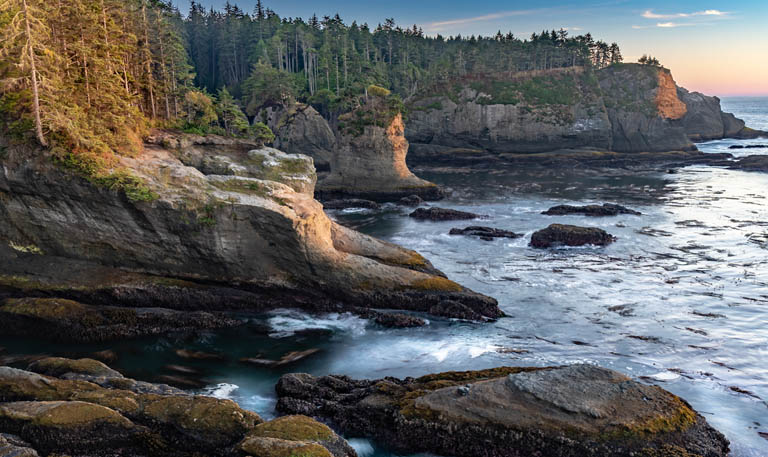The first Native American scenic byway in the United States begins on a winding coastal Olympic Peninsula road abutting the Strait of Juan de Fuca, the Salish Sea’s outlet to the Pacific Ocean. Created by a 2002 agreement between the Makah Tribe, who has inhabited the land since time immemorial, and the Washington State Transportation Commission, the final 12 miles of SR 112 located on Makah land is known as the Cape Flattery Tribal Scenic Byway. Beginning at the entrance to the Makah Reservation, the road winds through the town of Neah Bay and ends at a parking lot for Cape Flattery Trail, the northwestern point of the lower 48.
While the byway offers jaw-dropping landscape, the journey also encourages an understanding of the Makah people, a Washington tribe whose history and culture are shaped by a rugged marine coastline, whaling and fishing traditions guaranteed by an 1855 treaty and the 1970 unearthing of one of the tribe’s traditional villages. The excavation of Ozette village redefined both state archaeology and tribal rights.
On the route’s front porch there is a pullout at the reservation entrance sign where a break in the treeline offers a view of Sail and Seal Rocks. The two offshore features in the Strait of Juan de Fuca are popular feeding grounds for juvenile gray whales and sea lions that sun themselves on the rock perches.
Neah Bay is home to the renowned Museum at the Makah Culture and Research Center. It’s worth devoting a couple of hours to wander the thoughtfully curated introduction to the land, history, and culture of the Makah. Designed by tribal members and an internationally recognized museum architect, the facility serves multiple purposes.
It was built to house artifacts from Ozette, some over 2,000 years old. Located on a beach 15 miles south of Neah Bay, Ozette was buried under a mudslide until exposed by tidal erosion in 1970. Eleven years of excavation by the tribe and archaeologists from Washington State University recovered more than 55,000 artifacts, many of them perfectly preserved, with 500 of them displayed at the museum, and the rest in the museum’s repository. Additionally, the museum contains a longhouse, displays of modern basketry and cedar canoes used in whaling and fishing, all exhibited according to Makah seasonal practices. The facility also serves as a research center allowing current generations of tribal members and non-tribal experts the opportunity to study Ozette artifacts to renew traditional art, practices, and the Makah language.
Fort Nunez Goana–Diah Veterans Park, is a small beachfront monument commemorating both Makah veterans and a short-lived fort built in 1792 by Spanish colonists hoping to give Spain a base to protect political and commercial interests in the area. Though the settlement had a church, bakery, infirmary, housing, corrals, and a garden, it was a tense occupation of Makah land. The Spanish abandoned the fort four months after building it.
Popular Hobuck Beach Resort is a tribally owned enterprise with oceanfront cabins, an RV park and tent camping. It offers plenty of beach exploration, surfing the possibility of spotting some of the 239 species of year-round and seasonal birds that inhabit the area.
The end of the byway opens to one of the most breathtaking coastal scenes in the United States—the Cape Flattery Trail. The 1.5-mile roundtrip hike follows boardwalk and gravel to four observation decks where visitors can view the confluence of the Pacific Ocean and the Strait of Juan de Fuca, sea caves, and the 20-acre Tatoosh Island. The island was the site of a Makah summer village and today houses a lighthouse and the remains of an old weather station.
Fall and winter bring unique recreational and cultural opportunities. On the weekend closest to August 26, the tribe celebrates Makah Days commemorating August 26, 1913, when the U.S. government conferred citizenship on tribal members. October is the Hobuck Paddle Surf Festival. Several tribally owned fishing and whale watching charters operate out of Neah Bay’s port, while November to March is the best time to witness winter storm waves.
Like other tribes in Washington, the Makah have sovereign nation status and can establish regulations governing tribal land and expectations for guests. In 2020, the reservation and byway were closed to non-tribal members for two years to reduce the spread of COVID. A Tribal Recreational Use Permit, available at various locations in Neah Bay, is required for access to recreational areas including all public beaches and trails. Alcohol, marijuana, and all illegal drugs are forbidden, as are the removal of cultural natural resources including plants, animals, and shellfish.
Be mindful of visitor protocol during your journey but also know the word Makah refers to the tribe’s reputation for hospitality reflected in its tourism greeting: “Welcome to the beginning of the world and the home of the Makah—the Cape People.”
Ann Randall is a freelance writer, organizational consultant, and independent traveler who loves venturing to out-of-the-way locales, from Azerbaijan to Zimbabwe. Retired from a career as a teacher and union organizer in public education, she now observes international elections, does volunteer work in India, and writes regularly for 3rd Act, Northwest Travel & Life, West Sound Home & Garden, Fibre Focus, and Dutch the Magazine.


